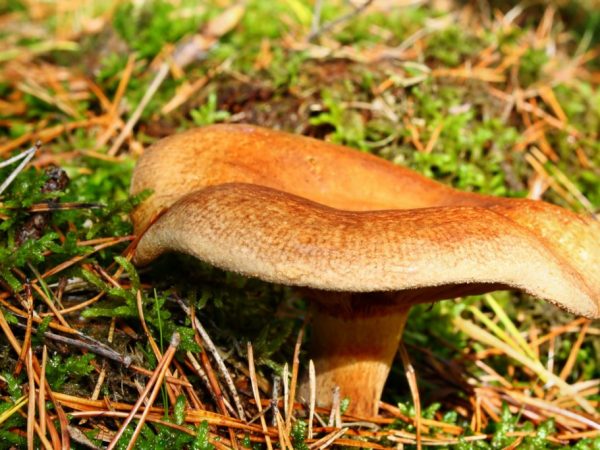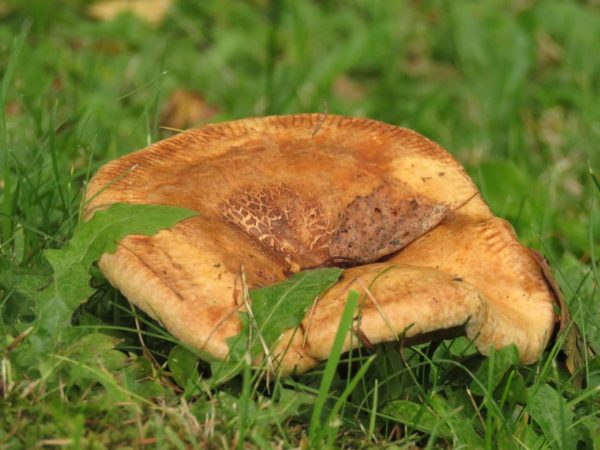The dangers of eating pig mushrooms
It is important for a real mushroom picker to be able to distinguish edible fruit bodies from inedible ones. On the way of a person can meet a pig mushroom (popularly - "dunka"). It is highly toxic and has the ability to accumulate heavy metal salts.

The dangers of eating pig mushrooms
Description of pigs
Pigs belong to the Pig family from the order Boletovye. "Dunki" have more than 30 varieties. A description of the appearance of the fruiting bodies of representatives of the genus Paxillus allows us to highlight common features:
- Head edge shape: wavy, at a certain angle, the hat itself resembles a pig's piglet.
- Hat: fleshy and spreading. The shape is elongated or round. The average size of the cap is 10-15 cm. Some specimens grow up to 35 cm. In young fruiting bodies, the shape of the cap is convex. With age, it levels out, becomes dry and cracked. A depression is formed in the center. Dry and rough surfaces become sticky after rain. The color of the cap also varies. There is a pig in white, brown, olive, brown and black colors.
- Pulp: firm but soft. It has no smell or taste.
- Leg: solid, short. The color of the leg is the same as that of the cap or slightly lighter.
- Appearance: the fruiting body externally looks like a lump.
Types of mushrooms and their distribution
There are a large number of pig varieties. All of them grow in deciduous and coniferous forests, and they also love swampy areas. Dun'ki prefer a temperate climate, so they are often found in Europe, Asia and even North America.
The pig is a whole genus of mushrooms. There are 35 species in total. The most common pigs are:
- S. thin: such fruiting bodies are popularly known as poddubniki. They usually grow at the roots of fallen trees. Their cap is round, slightly wavy. The diameter often reaches 20 cm. The color of the surface is brown. As it ages, the cap takes on a gray tint. The leg is creamy, short, up to 8 cm long.
- S. alkhovaya: common in most European countries. It differs in a funnel-shaped hat with a diameter of 6-8 cm. This type of pig has a brown hat with a scaly structure, there are cracks. The pulp is yellow, there is no smell.
- C. felt (black pig): grows only in coniferous forests. This mushroom has a large rounded cap, the edges of which are bent towards the leg. Surface color is brownish, brown. A black tint often appears. The leg is brown or brown, with a velvety surface.
- C. ear-shaped: It has a small leg size (no more than 3 cm) and a large fan-shaped hat. Its size can reach 14 cm. The surface of the cap is rough, but becomes smooth with age. The color is light brown. The pulp is yellow, has a coniferous aroma.
- S. giant: such a "dunka" has a huge hat. Diameter - 25-30 cm. Wavy shape, white color. The species is common in Europe. Representatives of the species are found on the territory of Russia, as well as the Caucasus.
In the forests of North America, there are mushrooms of the Spring Pig (Paxillus Vernallis). This species is known for symbiotic relationships with some woody plants: birch and aspen.
Irina Selyutina (Biologist):
- Formally, the spring pig was described in 1969 by Roy Watling based on materials collected by Alexander Henchett Smith in 1967.
- To date, it has been established that the terms of fruiting of the spring pig and with. fine coincide in time.
- Due to the strong external resemblance to a slender pig, recognized as poisonous, the mushroom picker should be extremely careful when collecting.
- Studies of the genus Paxillus are currently not being carried out on the territory of the Russian Federation, therefore, some mycologists are sure that they may not have encountered the species of spring pig, but a species that has not yet been described grows on the territory of the country.
Southern European countries suffer from the spread of another poisonous fungus of this genus - the ammonia pig (Paxillus ammoniavirescens). It can be found not only in forests, but also in city parks and alleys next to coniferous and deciduous trees. Representatives of this species simply occupied Italy, France, Portugal, Spain. You can find it in the north of Africa. The appearance of the mushroom is similar to other members of the genus. It has a spreading fleshy cap of beige or olive color with a diameter of up to 15 cm. It is rough at the edges, and smooth in the center. Medium leg, 5-8 cm.
Is the pig edible

The pig belongs to the poisonous species of mushrooms.
For novice mushroom pickers, pig mushrooms often seem similar to other edible mushrooms. These poisonous representatives of the kingdom of Mushrooms grow in the same conditions as edible fruit bodies.
“Dunka” was banned from collecting in 1993 due to a whole series of poisonings. The first known case of human death is dated 1944 (Germany), when the mycologist J. Schaeffer tasted pig mushrooms. He had severe abdominal pain, vomiting and diarrhea. Sheffer died on the 17th day after the meal.
The pig mushroom is inedible. The harm from its use is as follows:
- Pig mushrooms contain dangerous toxins - lectins, the concentration of which remains high even after prolonged heat treatment of fruit bodies.
- Certain varieties of the mushroom contain muscarine poison, the toxicity of which is comparable to that of the red fly agaric.
- The product contains specific antigens, when they enter the body, the cell membranes of the mucous membrane of the internal organs are destroyed. The result of eating such fruiting bodies is practically unpredictable. Development of anemia, nephropathy or renal failure is possible.
- The pig mushroom contains chemical compounds based on heavy metals, as well as radioactive particles.
The pig is a poisonous mushroom, even its accidental use leads to allergic reactions, disruption of the activity of internal organs and systems, severe poisoning and death. Having seen the place where such a mushroom grows, it is better to bypass it. If in doubt, the find should be shown to an experienced mushroom picker, who will tell you whether these are false bodies or not.
Signs of poisoning
Pig mushrooms were previously considered edible, since signs of poisoning did not always appear. The reason is the different individual sensitivity of people to heavy metals and poisons contained in fruit bodies.
The greatest harm was received by people with health problems, or children, since in some the immune system has not yet fully formed, while in others it is weakened due to health problems. After eating the mushroom for 1-3 hours, symptoms do not appear. Later, people begin to worry:
- nausea;
- vomiting;
- stomach ache;
- diarrhea;
- yellowness of the skin;
- dizziness.
In case of poisoning, an increase in hemoglobin in the urine is observed. The activity of the kidneys is also impaired. Urination becomes rare, there is a risk of oligoanuria.
The benefits of pigs
The benefits and harms of pigs are discussed by specialists of different profiles quite often. This type of mushroom is poisonous, but will not cause harm if used correctly. The benefits of pigs are the same as those of eating edible varieties of fruit bodies. They are also rich in vitamins, amino acids and proteins, contain a large number of trace elements: magnesium, phosphorus, potassium, etc.
It is not dangerous to consume such gifts of the forest if prepared correctly. They will not lead to poisoning or other consequences if:
- Clean them in the first hour after collection.
- Soak the peeled fruit bodies for 24 hours in a saline solution with citric acid (this is important for removing poisons and heavy metals from the product).
- Rinse the soaked mushrooms under running water and boil in salted water for 5-7 minutes.
The pig mushroom is dried, and then cooked as desired: stewed with meat and vegetables, included in first courses, pickled or added to salads. Pig mushrooms are also harvested for the winter. But it's better not to risk it and leave them to grow where you saw them.
Conclusion
Pigs are representatives of the genus, some of whose species are classified as conditionally edible, and most of them are poisonous. This majority is saturated with toxins, heavy metals (salts and ions) and radioactive particles (radionuclides). People living in villages continue to collect this mycelium and eat it, because their ancestors did so. The main thing is to properly process it after collection, then the risk of poisoning will be minimized.



